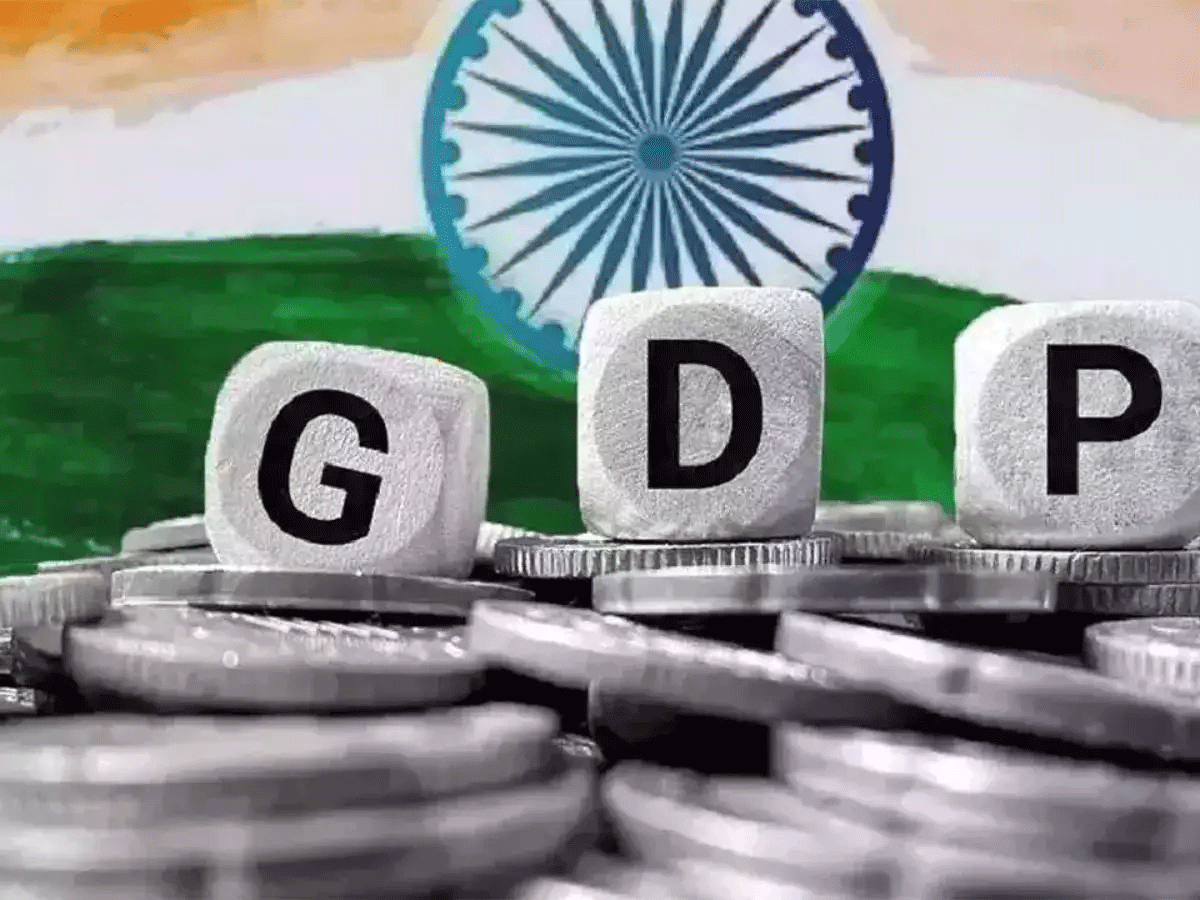- Courses
- GS Full Course 1 Year
- GS Full Course 2 Year
- GS Full Course 3 Year
- GS Full Course Till Selection
- Answer Alpha: Mains 2025 Mentorship
- MEP (Mains Enrichment Programme) Data, Facts
- Essay Target – 150+ Marks
- Online Program
- GS Recorded Course
- Polity
- Geography
- Economy
- Ancient, Medieval and Art & Culture AMAC
- Modern India, Post Independence & World History
- Environment
- Governance
- Science & Technology
- International Relations and Internal Security
- Disaster Management
- Ethics
- NCERT Current Affairs
- Indian Society and Social Issue
- NCERT- Science and Technology
- NCERT - Geography
- NCERT - Ancient History
- NCERT- World History
- NCERT Modern History
- CSAT
- 5 LAYERED ARJUNA Mentorship
- Public Administration Optional
- ABOUT US
- OUR TOPPERS
- TEST SERIES
- FREE STUDY MATERIAL
- VIDEOS
- CONTACT US
Revising GDP Base Year
Revising GDP Base Year

Why in the News?
- The Secretary in the Ministry of Statistics and Programme Implementation, said that the government will revise the base year for calculating GDP.
- Gross Domestic Product (GDP) is the total monetary value of all final goods and services produced within a country’s borders in a specific time period (usually a quarter or a year).
- The current base year is 2011-12, and the new base year will be 2022-23.
- This change will be done in February 2026.
- The base years for other economic indicators like the Index of Industrial Production (IIP) and the Consumer Price Index (CPI) will also be changed to 2022-23 and 2023-24 respectively.
- These updates are important to reflect the real state of the Indian economy.
What is the Index of Industrial Production (IIP)?
Key Features of IIP:
What is the Consumer Price Index (CPI)?
Key Features of CPI:
Types of CPI in India:
|
What are the Key Highlights?
- Historical Background
- The first national income estimates were prepared by the National Income Committee (1949), chaired by P.C. Mahalanobis.
- Reports were released in 1951 and 1954.
- Base year revision is not just a numerical update, it involves a comprehensive overhaul of how GDP is calculated, It reflects Improved economic structures, updated data sources, Global best practices.
- The planned base year update in 2017-18 did not happen due to problems in key surveys and data quality.
- The base year of GDP in India is revised by the National Statistical Office (NSO).
- Earlier It was known as the Central Statistics Office (CSO), which was merged with the National Sample Survey Office (NSSO) in 2019 to form the NSO under the Ministry of Statistics and Programme Implementation (MoSPI).
- The first national income estimates were prepared by the National Income Committee (1949), chaired by P.C. Mahalanobis.
- Timeline of GDP Base Year Revisions:
|
Revision Number |
From Base Year |
To Base Year |
Date of Revision |
|
1st |
1948–49 |
1960–61 |
August 1967 |
|
2nd |
1960–61 |
1970–71 |
January 1978 |
|
3rd |
1970–71 |
1980–81 |
February 1988 |
|
4th |
1980–81 |
1993–94 |
February 1999 |
|
5th |
1993–94 |
1999–2000 |
January 2006 |
|
6th |
1999–2000 |
2004–05 |
January 2010 |
|
7th |
2004–05 |
2011–12 |
January 30, 2015 |
What are the Significances of the GDP Base Year Revision?
- Improved Accuracy and Relevance:
- Reflects the current economic structure, such as rising dominance of the services and digital sectors.
- Uses updated prices, consumption patterns, and production data for more realistic GDP estimation.
- Enhances accuracy of sector-wise estimates (agriculture, industry, services).
- Restoration of Data Credibility:
- Addresses controversies from the 2015 revision, including allegations of GDP overestimation.
- Helps rebuild trust in India’s macroeconomic data, especially among economists and independent experts.
- Reduces reliance on outdated or inconsistent data sources (e.g., outdated Census).
- Strengthening Policy Formulation:
- Accurate GDP data is vital for evidence-based policymaking in areas like employment, poverty alleviation, taxation, and investment.
- Enables better design of welfare schemes by understanding sectoral and regional contributions more clearly.
- Meeting Global Data Standards:
- Aligns India’s GDP estimation methodology with international best practices (UN System of National Accounts - SNA).
- Enhances India’s credibility with global agencies like IMF, World Bank, and credit rating agencies.
- Investor Confidence and Capital Flows:
- With India emerging as the third-largest economy (in nominal terms), transparent and robust GDP figures are essential for Foreign Direct Investment (FDI), Portfolio investment, and Sovereign ratings.
- GDP data affects risk perceptions, bond yields, and capital inflows.
- Correction of Sectoral Distortions
- Brings improvements in estimates from manufacturing, informal sector, and new-age digital services.
- Integrates GST and digital transactions more efficiently and accurately.
What is the meaning of “third-largest economy (in nominal terms)”?It refers to a country's Gross Domestic Product (GDP) measured at current market prices (without adjusting for inflation or cost of living), and converted into a common currency, usually US dollars. Breakdown of the term:
|
What are the Challenges and Way Forward?
Challenges |
Way Forward |
|
1. Credibility Crisis due to 2015 revision controversy |
Ensure transparent and peer-reviewed methodologies; publish full details of data sources |
|
2. Delayed Revision (missed 2017–18 cycle) |
Adopt a fixed 5-year revision cycle as recommended by the National Statistical Commission |
|
3. Data Quality Issues in sources like MCA-21 vs. ASI |
Use triangulation from multiple sources (MCA-21, GSTN, ASI, NSS) to validate estimates |
|
4. Gaps in Employment, Consumption, and Poverty Data |
Resume and strengthen PLFS, CES, and conduct Census 2021 promptly |
|
5. Underrepresentation of Informal Sector |
Improve coverage of unorganised sector through field surveys and local economic data |
|
6. Political Interference in Statistical Processes |
Ensure institutional autonomy of NSO and MoSPI; involve independent statisticians |
|
7. Global Scrutiny as India Rises in Rankings |
Align with UN System of National Accounts (SNA) and international norms |
|
8. Sectoral Distortions in Manufacturing and Services |
Update sectoral classification and pricing with current market practices and digital economy |
|
9. Investor Skepticism due to inconsistent indicators |
Publish real-time metadata, provide methodological transparency, and encourage dialogue with experts |
|
10. Lack of Real-Time High-Frequency Indicators |
Integrate real-time data tools (e.g., e-invoicing, GST analytics, UPI trends) in GDP estimation |
Conclusion
GDP data is like the report card of a country’s economy. For people to believe in this report card, the data must be honest, timely, and updated. In today’s world, where India is attracting global attention, the need for credible and updated GDP data is more important than ever. Strengthening the statistical system with transparency, independence, and modern techniques is not just good practice. it is essential for India’s growth story to be trusted, both at home and across the world.
What is MCA-21?
Key Features of MCA-21:
Periodic Labour Force Survey (PLFS)
Consumer Expenditure Survey (CES):
|
|
Ensure IAS Mains MCQ
Q. Revising the base year for GDP calculation is essential for reflecting the true structure and performance of an evolving economy. Discuss the rationale, significance, and controversies associated with the periodic revision of GDP base year in India. Also suggest ways to improve the credibility and accuracy of GDP estimates. (250 Words) |
Ensure IAS Prelim MCQQuestion:With reference to the Consumer Price Index (CPI) in India, consider the following statements:
Which of the statements given above is/are correct? (A) 1 and 2 only Answer: BExplanation:
|



